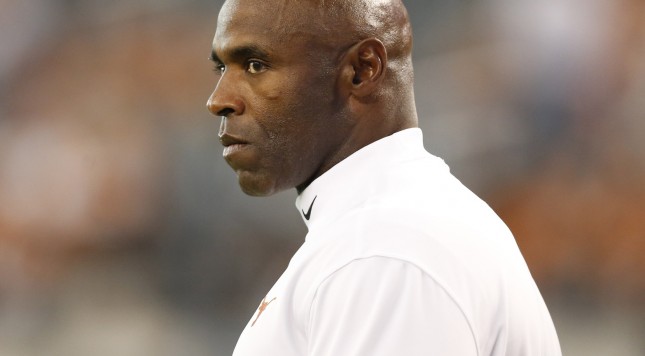Roster churn is universal in college football during times of regime change. Everything being bigger in Texas, the transition from Mack Brown to Charlie Strong has produced a particularly robust number of defections in the last two years.
The notable attrition has been attributed to Strong’s desire to rehabilitate the culture of Texas football. After inheriting a soft, undisciplined outfit, the new sheriff is giving the 40 Acres’ bad apples enough rope to hang themselves. Give ’em all five core values to abide by and let the drug tests sort ’em out.
So far, Strong’s reclamation effort has generated far more plaudits for its intentions than tallies in the win column. That’s to be expected when you’re essentially starting over from scratch. Not surprisingly, Strong appears confident that the wins will come once he gets his own players in place.
Lately, it looks as though the timeline for getting Texas back on top is being stretched out a bit.
In the short term, the purge has dented UT’s depth at a number of positions:
- Redshirt freshman running back Duke Catalon reportedly walked out of practice earlier this week, leaving unheralded sophomore D’Onta Foreman vying with three true freshmen to back up senior Johnathan Gray, who’s less than two years removed from a torn achilles, at tailback;
- After a slew of upperclassmen hit the bricks, true freshmen Patrick Vahe and Connor Williams look like they may get the call as starting offensive linemen against Notre Dame;
- Three middling upperclassmen and eight freshmen comprise the linebacker corps;
- True fish DeAndre McNeal apparently has the inside track at tight end;
- What’s on hand at the quarterback position won’t inspire much confidence.
Recent developments cloud the long-term outlook as well. The reality is that Strong’s first real recruiting class has lost some luster since the ink dried in February:
- Four-star linebacker Cecil Cherry lasted a handful of practices before bouncing back to Florida earlier this week;
- The only defensive tackle in the entire class appears to be on the verge of jilting the Longhorns for their blood rivals after failing to meet UT’s entrance requirements;
- Amid longstanding concerns over his ability to qualify, tight end Devonaire Clarington, another four-star prospect out of Florida, has yet to make it to campus;
- Lanky wideout Gilbert Johnson didn’t qualify.
Individually, none of the losses from the new class signifies some kind of mortal wound to the program. It’s a fact of life in college football that some recruits never make it to campus. With 29 spots in the class, there’s room for a few fliers.
Taken as a whole, however, it should raise a few eyebrows regarding how Strong is going about remaking the roster. Strong and his staff aren’t responsible for the choice Cherry made to leave the program, nor is it on them to get recruits to pass a Spanish class. The coaches are responsible for assessing risks, though.
If a recruit’s father isn’t down with his son leaving the Sunshine State for Texas, is it worth investing the time and resources courting him? When you’re shedding upperclassmen left and right, how many borderline academic cases can you afford to take? And maybe the biggest risk of all: alienating the notoriously touchy fraternity of high school coaches in Texas by passing over in-state prospects for talents outside the Lone Star State’s borders.
Maybe it’s all just a small bump in the road on the way back to national prominence. There’s no real doubting Strong’s coaching acumen at this point, and he clearly possesses confidence in his vision of what he wants from his players. Even if he’s re-examining his choice of offensive scheme, he doesn’t seem to doubt his blueprint for rebuilding the Texas program.
Yet, since Strong took over at Texas, the odds have gradually stacked against some kind of smashing success in the five-year timeframe of his contract. He still has plenty of time to turn the Longhorns around. That likely hinges as much now on adapting to the realities of his job as bending them to his will.

